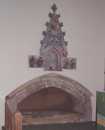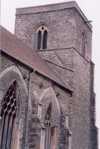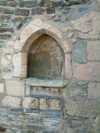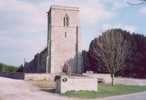For this church:    |
| |||||||||||||||||||||||||||||||||||||||||||||||||||||||||||||||||||||||||||||||||||||||||||||||||||||||||||||||||||||||||||||||||||||||||||||||||||||||||||||||||||||||||||||||||||||||||||||||||||||||||||||||||||||||||||
 The
Easter Sepulchre The
Easter Sepulchreas it currently appears |
The Easter Sepulchre was probably hidden soon after 1559 when Elizabeth I became queen, when ‘popish practices’ disappeared from the Church of England for almost 300 years. It may have been packed with straw and plastered over in order to preserve it.
In 1603 there is a record of a receipt from Rev. Hugh Hookes, a vicar of the cathedral church of St Peter of York, for 3s 4d (half pension of 6s 8d) due out of Sibthorpe to the deacons of the cathedral.
Richard Whalley, having purchased Welbeck Abbey, had a grant of the college and its wardenship, subject to the life of Thomas Magnus. The manor of Sibthorpe, the manor house called Chauntrie or College House, dovecote, and specified closes, also the Rectory and Tithes and all property of the late Chantry passed to Sir Charles Cavendish of Welbeck in 1606/7. This property was sequestered and sold by the authorities and by Newcastle trustees to Edward Whalley, son of Richard. Sir Robert Harley, 1st Duke of Oxford, petitioned Charles II to arrest the “traitor convict” Whalley, who was then charged with high treason and had all his property confiscated. Charles II then re-bestowed the Sibthorpe estate on the Marquis of Newcastle upon Tyne, from whence it passed to the Dukes of Portland through marriage.
The manor house is described in a lease of 1624 as “a great chamber, and other rooms built and repaired with the yard called the Trinity Garden, the old stable and four bays of the barn and part of the ground in the little court to make a garden plot” leased for 12 years at 6s 8d p.a.
George Cooke of Sibthorpe was a lay commissioner for Notts and Derby charged with carrying out the Act of Ordinances (1654), which was intended to remove scandalous or inefficient ministers from their livings after the Restoration of Charles II. However, when he offered to preach in church in 1660 he was “violently hindered by two men that forced the pulpit door against him when opening it and crushed his hand: upon which he withdrew and said they were a wicked generation and he would no more join with them. He was a good scholar and a great disputant and a sound preacher. He removed himself shortly afterwards to London”.
A document of 1660, citing an act of Parliament forfeiting to the King the “estates of the regicide”, refers in detail to the farms and closes in the village: The Hall, closes called the Parke, New Field, Middlebeck, Fowler Close, the Furrfield, the Stockclosing, the West Ing, Milneclose, Hawkesworth close, Halfemotes, Flashclose, Masons Close, Nether Stonepit Close, Common Close, Over Stonepit Close, Harrisons Farm, Home Close, Ten Shilling Close, and Closes called Conigree, the Motes, Over Stringer, Stubbles, Butlers, Outram, Croepark and Nether Stringer.
An order in Parliament dated 1661-2 stayed all actions by and on behalf of John Whalley against the Marquis of Newcastle concerning property in Sibthorpe, in which property the Marquis was to have undisturbed possession “during the privilege of this Parliament”.
 Original
north aisle Original
north aislewindows used in the current north wall. Filled-in arches and corbels are visible. |
 Former
piscina, Former
piscina,now on the exterior north wall |
Bailey (1900) says that both aisles of the church were demolished in 1662 (not giving his source), whereas Throsby (writing 1786-90) says that one aisle was taken down “about 40 years ago”, i.e. c.1746. The windows of the north aisle were reused and incorporated into the north wall of the nave.
In 1715 Lord Harley’s agent wrote that he had collected rents of £400 from all but 3 or 4 tenants at Sibthorpe and Cottam. He promised wood to those who paid to allow them to repair their wind-damaged houses after a “great harakin”. A later letter said that some tenants were proving difficult to convince and he may have to use “prudent severities” if they prevaricated for more than a week. The tenants were desperate for wood. Twelve years later, a footnote in the parish register of 1727 records a violent shock of an earthquake followed by a distemper.
A parochial visitation order for 1718 required the following work to be carried out; 'The church to be repaired in the outer walls, windows, roof and pavement, and to be white washed all over within. The following printed items to be supplied: the Ten Commandments, the Creed, the Lord's Prayer, and the King's Arms. The following fittings to be supplied: a new pulpit cloth and cushion, a carpet for the communion table, a basin to collect the alms and a new cloth to cover the reading desk. The impropriators or farmers must repair the chancel in the roof, outer walls, windows, and pavement where wanting, and white wash it all over inside.' In the next year a certificate was issued on 18 April 1719 confirming that the work had been done.
In 1720, 706 acres were leased to four tenants for between 10/- and 13/3d an acre. The Portland estate, however, retained the rights of woods, mines, quarries, fish, fowl, game and hunting. Tenants were covenanted to fetch one load of boone coal to Welbeck (or pay 2/- fine in default), and keep a hound dog yearly for the use of Lord Harley.
A writ of 1616 lists the following properties in the village: Manor or chantry with 10 messuages, 8 cottages, 1 windmill, 2 dovehouses, 500 acres land, 200 acres meadow, 300 acres pasture and 500 acres furze and heath. A later lease of 1722 covering Sibthorpe and eight other villages lists 50 messuages, 10 cottages, 2 mills, 20 dovehouses, 50 gardens, 1500 acres of land, 800 acres meadow, 800 acres pasture and 500 acres heath and ling.
In 1723 a mortgage was taken out for the manor, the capital messuage called the Chauntry or College House, the rectory and tithes of Sibthorpe and estate therein (and 8 other villages) for a period of 1000 years for a sum of £16,000. The mortgage changed hands several times between 1735 and 1789/90, when the 3rd Duke of Portland redeemed it.
In 1754, Sibthorpe was a donative of the Countess of Oxford (daughter of the 3rd Duke of Newcastle upon Tyne).
An agricultural survey of Nottinghamshire reported that Sibthorpe had 7 births and 6 burials for the 5 years 1789-93.
Shortly before 1793 Sibthorpe was one of several Nottinghamshire parishes where enclosure had been made without parliamentary authority and was completed by 1798. However, it may have been partially enclosed in the time of Henry VIII.
In 1832 the village supported farmers, a shoemaker, shopkeepers and a baker. In 1844, a blacksmith is added to the list and in 1885 a school-mistress, carrier and general dealer. By 1922 there is a threshing machine owner, an agricultural engineer, cycle agent and motor garage supplies. In 1936 the only occupations given are farmers and blacksmith.
Parish accounts of the early C19 contain frequent payments of 1/6d per 6 dozen, and 1/- per 4 dozen for sparrows.
A visitation in 1603 suggests a population of 83, of which 52 (63%) were communicants, and 31 (37%) under age. There were no recusants. In 1676, 47 persons were of age to take communion, no Popish recusants, and 6 absented themselves from church. The Religious Census of 1851 shows that out of a population of 146, there was a general church congregation of 44 for afternoon services with 18 Sunday scholars, and 60 for the Wesleyan evening service. In an 1871 survey there was seating for 162 in the church and 58 in the chapel.
Mrs J. Banks Wright erected a school in 1846 and the Rev. Banks Wright maintained the school in 1864. In 1953 a decision was made to sell the schoolhouse at Top Green and since then it has been a private house.
A letter to the 5th Duke of Portland in 1864 advised him that as Sibthorpe and Cotham are donatives, his right of presentation could not lapse unless he accepted Queen Anne’s Bounty. A clergyman is recommended.
In 1907 all baptism fees were abolished and a fee of 5/- paid to the sexton for each grave, provided that after settlement the grave was finished off to the satisfaction of the churchwardens.
According to a minute book of 1910 there was an argument with the vicar about the continual changing of the service. The vicar refused to put a motion to the meeting and three people, including the churchwardens, walked out.
After the First World War, the 6th Duke of Portland began selling off property in the village to tenants. The first was to Edward Fox, who paid £275 for 5.397 acres. A sales catalogue lists freehold agricultural estates also in Cotham, Alverton and Kilvington. Firs Farm in Sibthorpe and Elston was sold for £8275 in 1919.
In 1922 the 6th Duke of Portland insured the church with the Alliance Assurance for £4000, premium of £3.
In 1944 there was the prospect of curtailment and withdrawal of the Duke of Portland’s contribution to the benefice.
Nonconformity
By 1818 new Primitive Methodist Societies were starting to spread into outlying villages including Sibthorpe. In 1844 a movable wooden chapel standing on four solid oak wheels was built for the Wesleyan Itinerant Bethel Community. It was made by Mr Clifton of Bingham at a cost of £60 and was capable of seating 130 persons. (There is some conflict here as 35 years later a survey of 1879 stated the chapel held 58). It was designed to serve a group of small villages in the circuit where it was impossible to obtain a permanent site as the land was the property of noblemen or other landed proprietors.
The chapel was declared “now opened and nearly completed” on 13th September 1844. John Shelton of Nottingham delivered two powerful and appropriate sermons to about 120 persons. At the close of each service collections were made, which together with the proceeds of a tea meeting, which took place during the interval between services, and previous donations, raised £50.
The chapel stood on a plot of land off Top Green, the site being a gift from the Duke of Portland to a nonconformist farmer. Though small, it was comfortable inside with oil lamps and solid fuel for heating. It was warmer and more draught-proof than the church. The sound of hymn singing accompanied by a harmonium often drew cows to the door where they often joined in with moos.
The chapel was bought for £30 in 1947/8 by Mr Gilbert of Bingham who used it as a garage for his taxi business at Flawborough. It was finally bought by Mr Baguley of Staunton who took it there and used sections of it to make various sheds. The slates from the roof were sold to help pay for the removal of the chapel.
There was never a permanent chapel building in the village and that is the situation today.
Restoration and Repairs
In 1635-40 it was reported that there was no rail, the ridge-tree of the roof was much decayed, seats needed repair and the floor was unpaved and unboarded. In November 1638 the alleged ridge-tree and seats were completed.
A Parochial Visitation book of 1718 called for “the church to be repaired in respect of outwalls, windows, roofs and paint where wanting to be whitened all over within. The Ten Commandments, the Creed, Lord’s Prayer and King’s Arms to be done now. The chancel likewise in the outwalls, windows, roofs and paint whitewalls all over within. My Lord Harly, Impriator”.
Another early C18 visitation required “that a schedule and duplicates thereof of the books, vestments and vessels belonging to the church both signed by the minister and churchwardens be brought with the register books to the Visitation to be held at Newark in October next; that a new surplice be bought; that the chancel be repaired in the roof and floor made over, and that the churchyard stones be repaired”.
Early account books record payments for reglazing: £2.0.7d in 1812 and 18/- in 1814.
A restoration was carried out in 1853. Two windows (south?) were donated by private subscription of £5, but no further details of work done were given in the account books.
The Revd Mr Smyttan presented a paper in 1854 describing the church, and at the same time denouncing a restoration or “repair” that was currently being undertaken. He called for it to be stopped “until it could be seen whether a real restoration could be accomplished, not to restore it to its former size and beauty, but at least to ecclesiastical propriety and architectural correctness”. During the preceding winter “repairs” resulted in a chancel ceiling of “unblemished whiteness and smoothness”, which hid the upper part of the tracery of the east window. The windows had been scraped clean, thereby removing all soft tones of age and reducing the thickness of the stone. Mullions had been inserted into the Doric windows to “Gothicise” them. Blue and gold altar rails had been bought from a Newark church and the beam of the rood loft had been removed. The work was out of character and had been carried out by a builder commissioned by the patron’s agent and not by an architect. £190 had been assigned for repairs, the parishioners contributing £60, but not all had been spent.
An Act Book of 1853 records: 14/- paid for coals to dry the church; for boards, framing and altar rails to Newark church £8.14s.2d; £1.10s for pulling down a wall. This may have been the south wall of the nave, so criticised by Glynn thirteen years later. At this time the Burnell sepulchre was further east, partially obscuring the arch and recess of the founder’s tomb under the Easter Sepulchre. Bloxam says the Easter Sepulchre was ‘recently’ found by accident upon the removal of the monument, exposing the niche for the reception of the host. (This is contradicted insomuch as Throsby describes it in 1780. It should be noted that the Burnell tomb would not by itself have hidden the sepulchre as it is not tall enough even if it had been on a plinth. It is more likely to have been filled with straw and plastered over, as happened at Hawton.) Smyttan wanted the Burnell monument moved and the arch cleared of masonry. He also suggested that the tower might once have had a short spire.
Five years later, in 1858, there is a note that the church had undergone a “most agreeable metamorphosis”. Frightful old pews had been superseded, the graceful tower arch opened out, a new vestry built, Easter Sepulchre restored, old ceiling removed from chancel, a new roof built and a second piscina found near the one previously known. It was hoped to extend restoration to the whole fabric.
Glynn wrote in 1866 that the nave was mutilated and partly modernised, and noted that the chancel aisle was not in the centre and had a lopsided appearance. Noting that the south wall had been rebuilt in a very poor modern style, he suggests that the rebuilding line may not have coincided with the original. He said the east wall was “lately illuminated in colour” and mentions the now faded painted inscription in gothic script on the arch over the tomb recess, reading: “Their bodies are buried in peace, but their name liveth for ever”, with no suggestion as to whom this refers.
A motion was passed in the Minute Book of 1908 to ask the Duke of Portland’s agent if he would ‘be so kind as to repair the stone’.
The Duke of Portland gave £50 in 1917 towards improvements in the chancel. This resulted in the purchase of a new altar with hangings and curtains, a set of candlesticks, flower vases, a cross, the chancel whitened, the altar rails and choir desks repainted, a new oak kneeling desk and an oak chair for the Sanctuary.
In the severe winter of 1947 services were cancelled in February and March. Broken windows were replaced with wood in 1955 to keep out the pigeons. The problem of heating the church was raised in 1958 and permission sought to board-up the chancel archway so that services could be held in the chancel, heated by paraffin stoves. An alternative proposition was to hold services in the vestry. However, the following year, as the first option was considered too expensive, the second, i.e. vestry option was chosen, with some hardboard to seal off any draughts coming through the tomb recess beneath the Easter sepulchre. By 1960 no more money was to be spent on improvements until the future of the church was known, no doubt due to the clergy shortage.
The following year repairs were estimated at £2000. A Restoration Committee Log Book was started in 1961. In 1964 services in the church were discontinued due to danger from falling slates. Later in the year these were remedied at a cost of £56 8s 3d. By 1965 major restoration was necessary, but funds were low. A bricklayer was to examine the ceiling to ascertain if it was safe or likely to fall and until this was done services were suspended. The architect suggested that if the roof had to be pulled (or if it fell) down, the walls could be left standing and the space between the tower and chancel be turned into a garden. At a full Parish meeting it was unanimously agreed to fight to restore the church and keep it all as it stood. Fortunately when the roof was cleared out the timbers were found to be sound. The Guild of Bell Ringers repaired the broken bell-wheel and worn ropes. The cost, including timber treatment, roofing and guttering (carried out by volunteers under supervision) came to £596. This was reduced in the 1967 accounts to £190 16s 2d, thanks to a grant and sale of slates. Electricity was introduced in 1966 with heating bars under the pews, conversion of the candle-holders on the walls and the chandelier in the chancel. Heating had previously been by a coal stove on the north wall of the nave by the chancel arch, and by paraffin heaters.
Male volunteers carried out plastering and redecoration and female helpers used caustic soda to strip and remove old paint from the C16 pews and panelling, followed by re-waxing. New pew ends were made because the old pews had been fastened to the wall panelling. A chandelier for the nave, matching the one in the chancel, was made by Mr Willis of Screveton. The chancel roof was stripped and retiled with concrete tiles in 1968 and the tower was again further repaired the following year. The Bishop of Sherwood dedicated a new pulpit to Mr Avis (the force behind the restorations) in 1971. The altar cross also bears a dedication. The following year dry rot appeared on the pulpit and the floor was treated to combat both this and deathwatch beetle. Plastering was redone and a tank outside was moved away from the wall to reduce damp seepage. A gale in 1976 blew in a window. In 1987 the tower was re-leaded, pointed and access improved with the help of funds from the Historic Churches Preservation Trust and English Heritage.
By 1985 much needed repairs were estimated to cost £12,000. English Heritage gave a maximum grant of £5,658 on condition the tower roof was repaired with lead. Repairs to tower, windows and guttering were completed in 1988, but later in the year the architect said that there still remained £6,230 worth of repairs to be done including masonry and renewal of the bell chamber floor. The bell frame also needed attention.
The floor of the nave was excavated in 1991 so that new wood strip flooring could be laid, replacing the old red and blue quarry tiles. This exposed the foundations of the original south aisle wall and the central pier of the arcade. Finds included a grave slab with dates 1719 and 1726 (now in the churchyard), a piscina, small pieces of painted plaster - buff, yellow and red, small fragments of plain window and bottle glass, small bone fragments and a heavily sooted sheard of splashed glaze ware dated circa 1200. At the same time the foundations of the north arcade were traced by dowsing and probing.
In 1966 the Inspectorate of Ancient Monuments reluctantly agreed to the levelling of the fishponds of the medieval college and Mr K G Burton, farmer, carried out the work in April 1967. Before this he had already dug a number of trenches across the banks of a second enclosure, an action deplored by the archaeological community and sites are now scheduled to protect them from this type of action. The site has now been surveyed and there is an interpretive display board by a path leading to the site and dovecote.
Mention must be made of a theory by John Quarrell, rector of Hawton, that the college of chantry priests at Sibthorpe was actually at Hawton. He says that Sibthorpe simply was not large enough to host such an establishment. He argues that the site of the chapel of St Mary has not been found at Sibthorpe, although there is a large disturbed site to the south and east of the church. All the written evidence confirms the college was at Sibthorpe.
Population
| 1603 | 83 (est) | 1891 | 106 | ||||||
| 1801 | 85 | 1901 | 76 | ||||||
| 1811 | 98 | 1911 | 90 | ||||||
| 1821 | 142 | 1921 | 90 | ||||||
| 1831 | 144 | 1931 | 97 | ||||||
| 1841 | 154 | 1941 | |||||||
| 1851 | 146 | 1951 | 78 | ||||||
| 1861 | 142 | 1961 | 71 | ||||||
| 1871 | 141 | 1971 | 48 | ||||||
| 1881 | 130 |
Relevant dates and events
| 1086 | A church and priest in Domesday survey | ||
 |
|||
| 1185 | Interest in church given to Knights Templars | ||
 |
|||
| 1241 | First incumbent - John Cantuaria | ||
 |
|||
| 1312 | Knights Templars replaced by Knights Hospitallers | ||
 |
|||
| 1325 | Letters Patent from Edward II | ||
 |
|||
| 1341 | Thomas obtains advowson from Knights Hospitallers Foundation charter of College of Chantry Priests |
||
 |
|||
| 1351 | Thomas de Sibthorpe murdered. Buried in church | ||
 |
|||
| 1545 | College suppressed by Henry VIII | ||
 |
|||
| 1662 | Aisles demolished | ||
 |
|||
| 1720 | Estate passes to Duke of Portland | ||
 |
|||
| 1844 | Itinerant Bethel Chapel on wheels built Restoration of church criticised |
||
 |
|||
| 1858 | Further restoration approved | ||
 |
|||
| 1965 | Restoration to avoid demolishing nave | ||
 |
|||
| 1966 | Electricity connected | ||
 |
|||
| 1991 | Wood strip floor for nave | ||






